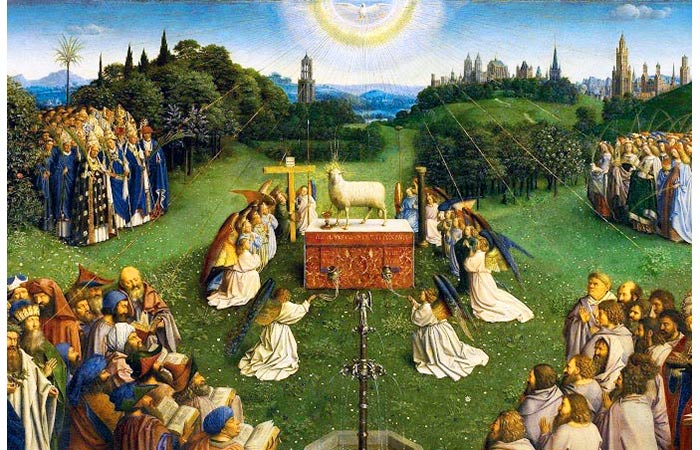Therefore God has highly exalted him
Philippians 2:9-11
and bestowed on him the name which is above every name,
that at the name of Jesus every knee should bow
in heaven and on earth and under the earth,
and every tongue confess that Jesus Christ is Lord,
to the glory of God the Father.
In the vision in the fifth chapter of Revelation when John found himself before the heavenly throne of God, the scroll that would unfold God’s plan for the human race was sealed. He was pointed to the one worthy to open the seal: Jesus Christ, the Lion of the tribe of Judah, the Root of David. Christ was worthy because of who he was. But he was also worthy because of what he had done.
The elder said to John, “[He] has conquered, so he can open the scroll and its seven seals” (Revelation 5:5). Because he has won a victory, he can fulfill God’s plan. When Christ was given the scroll by God, those in heaven sang a song of praise to him. This was a “new” song, that is, a song to celebrate the new conditions created by Christ’s victory:
Worthy are you to take the scroll
Revelation 5:9-10
and to open its seals,
for you were slain and by your blood
did ransom men for God
from every tribe and tongue and nation
and have made them a kingdom and
priests to our God,
and they shall reign on earth.
The scene itself is striking. The Lion is standing before the throne of God, closer to the divine majesty than the greatest of angelic beings. Apparently he is standing in the heavenly Holy of Holies, at the holiest point in the universe. But the Lion is “a Lamb, standing as though it had been slain” (Revelation 5:6).
The phrase is an odd one: dead lambs do not stand. John seems to mean that although he saw the Lamb standing and therefore alive, it was possible to see that he had been slain. His wounds, the signs of his death, were visible. His standing posture possibly just indicated that he was alive but more probably indicated that he was acting as a priest, because priests stand before God when they serve him. The Lamb, in other words, was standing before God, risen and victorious, but as the one who had died for the sins of the world. He was now in God’s presence as the High Priest, seeking the salvation of the world.
All of this is picture language. The same figure cannot be a Lamb and a Lion. Nor, when we enter heaven, will Christ look at us with seven eyes, as in the next phrase. But in some way that we cannot fully understand, he is and has been and will be in God’s presence as the Priest who was a sacrificial victim and as the King who conquered by being defeated. The visions of the Book of Revelation cannot be drawn without grotesqueness, because they are a fusion of different pictures, all of which have significance. But the details all reveal something about the heavenly fulfillment of the death of Christ on earth.
When did the events in John’s vision occur? Some have thought that the pause between the question and response indicates that John did not at first know what to look for, but Christ was there all along. Others have thought that heaven was opened to him so he could see what had happened when the risen Lord arrived before the throne of his Father. The dialogue with the elder does seem to indicate that the worthy one arrived while John was looking.
In either case, there is agreement that the vision is meant to dramatize the importance of the position Christ attained through the resurrection and ascension. Only after the arrival of the Lamb in heaven can God’s plan for the human race unfold, because only then has the work been accomplished that made it possible. Both aspects are important. Something has been accomplished on earth: atonement and victory. And the one who did it is now in the place where the events of human history are determined – before the throne of God – presenting what he has done and being given a response by his father in the form of the scroll that unfolds the plan for the victorious conclusion of human history.
John does not record any words of the Lamb. From that some have concluded that Christ did not say anything. He did not need to. His wounds and his risen humanity were enough. He simply needed to present himself in God’s presence since what he had done was well enough known to God. Others have held that he did speak, and the words of his intercession are echoed back to us in the song of praise. Christ certainly interceded, with or without words, since the role of a priest involves intercession on the basis of the sacrifice being offered. The Letter to the Romans says that, “[It is] Christ Jesus who died, yes, who was raised from the dead, who is at the right hand of God, who indeed intercedes for us” (Romans 8:34).
Ascended in the presence of God, Christ must have communicated something like this: “Here I am, Father, having completed the task you sent me to do. I have suffered and died for human beings. I have paid the price. I have given myself completely. Now look upon these wounds, the sign of my life given to you as an offering. Look upon the sacrifice, which I know is acceptable to you, and be gracious to those below. Accept them as well. Forgive them. Cleanse them. Pour out your blessing upon them, the gift of your Holy Spirit. Take them for yourself, holy to you. Free them from their bondage and bring them to yourself. May this offering I have made achieve the result for which it was given.”
In this chapter, we are primarily going to look at the resurrection and ascension of Christ. His death cannot be understood in isolation, no matter how useful it is to focus on it more extensively in order to understand its meaning. Explaining it all by itself is like describing a journey without mentioning the destination, or like saying to a child how good it was to make the last mortgage payment without her realizing that meant her family then owned the house. Christ’s death was only one step in a process, part of a transition from an earthly existence to a heavenly one. His resurrection and ascension completed that transition by bringing him into the heavenly position from which he could be the Redeemer.
Exalted Over All
The Scriptures describe the resurrection and ascension of the Lord as an exaltation. Both words indicate a going up, one a rising up from a fall, the other a climbing up from a descent. The resurrection and ascension, then, are the conclusion of the process we looked at in the previous chapters. Christ went down; he lowered or humbled himself. But he did so that he might be raised up. Raised on high, the Redeemer could bring about the results his humbling was intended for.
The word “exaltation” in Hebrew idiom is used to refer to a state of power or greatness or rule. A king is high or exalted. Anyone else is lower in rank by comparison. “Exaltation” can also be used to refer to victory. A victor is exalted or set on high, while the defeated opponent is humbled or brought low. But “exaltation” can also refer to going up to heaven because heaven is as high as someone can go.
Christ’s resurrection and ascension were his exaltation in victory to a position of authority and power, his exaltation to a heavenly place. From there he could exercise a heavenly priesthood and a heavenly kingship. Or to put it in another way, Christ was then in the kind of relationship with God that allowed him to bring about the redemption made possible by the sacrifice he offered in humility upon the cross.
The resurrection and the ascension are the conclusion of an exodus. They complete the passage of the Lord himself from a fallen or low state to an exalted or heavenly one. They also make possible our exodus from bondage to spiritual freedom and the enjoyment of our heavenly inheritance. In this chapter, we will look at what the resurrection and ascension resulted in for the Lord. In the next part of this book we will look at what it resulted in for us.
The Victory and Exaltation of the Redeemer – A 3 Part series, by Steve Clark
This 3 Part Series on The Victory and Exaltation of the Redeemer is excerpted from Redeemer: Understanding the Meaning of the Life, Death, and Resurrection of Jesus Christ, Chapter Ten, by Steve Clark © 1992, 2009. A free PDF copy of the book is available online for download from the Sword of the Spirit website. Check out other Sword of the Spirit books from the Sword of the Spirit Online Library.
Top image credit: The Adoration of the Lamb (detail), from the Ghent Altarpiece, painted by Jan van Eyck in 1432. Image in the Public Domain. Source: https://www.wikiart.org/en/jan-van-eyck/adoration-of-the-lamb-1429
Steve Clark has been a founding leader, author, and teacher for the Catholic charismatic renewal since its inception in 1967. Steve is past president of the Sword of the Spirit, an international ecumenical association of charismatic covenant communities worldwide. He is the founder of the Servants of the Word, an ecumenical international missionary brotherhood of men living single for the Lord.
Steve Clark has authored a number of books, including Baptized in the Spirit and Spiritual Gifts, Finding New Life in the Spirit, Growing in Faith, and Knowing God’s Will, Building Christian Communities, Man and Woman in Christ, The Old Testament in Light of the New.
- See articles by Steve Clark in Living Bulwark Archives



